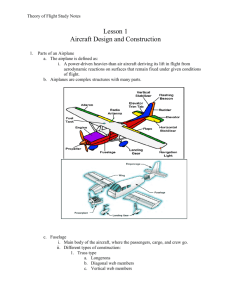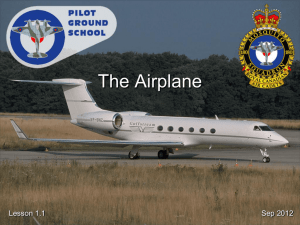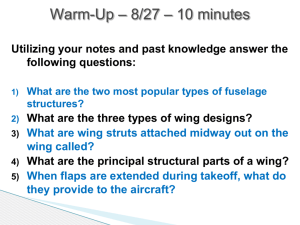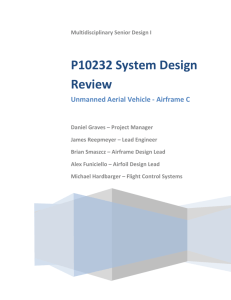6.01 Aircraft Design and Construction
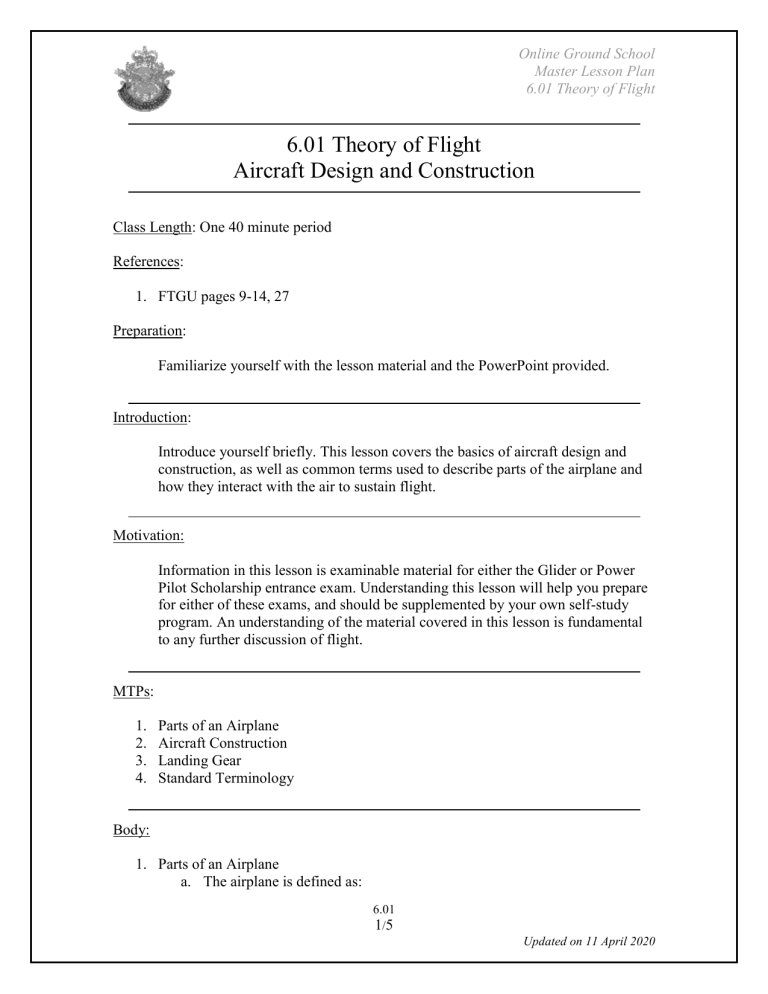
Online Ground School
Master Lesson Plan
6.01 Theory of Flight
6.01 Theory of Flight
Aircraft Design and Construction
Class Length: One 40 minute period
References:
1.
FTGU pages 9-14, 27
Preparation:
Familiarize yourself with the lesson material and the PowerPoint provided.
Introduction:
Introduce yourself briefly. This lesson covers the basics of aircraft design and construction, as well as common terms used to describe parts of the airplane and how they interact with the air to sustain flight.
Motivation:
Information in this lesson is examinable material for either the Glider or Power
Pilot Scholarship entrance exam. Understanding this lesson will help you prepare for either of these exams, and should be supplemented by your own self-study program. An understanding of the material covered in this lesson is fundamental to any further discussion of flight.
MTPs:
1.
Parts of an Airplane
2.
Aircraft Construction
3.
Landing Gear
4.
Standard Terminology
Body:
1.
Parts of an Airplane a.
The airplane is defined as:
6.01
1 / 5
Updated on 11 April 2020
Online Ground School
Master Lesson Plan
6.01 Theory of Flight i.
A power-driven heavier-than air aircraft deriving its lift in flight from aerodynamic reactions on surfaces that remain fixed under given conditions of flight. b.
Explain using the first diagram that airplanes are complex structures with many parts which can be broken down even further than this diagram. c.
Briefly point out and explain the function of the main parts of an airplane using the next diagram provided. i.
Fuselage ii.
Empennage iii.
Wings iv.
Landing Gear v.
Power plant d.
Use the next diagrams to illustrate that although many aircraft look quite different from each other, they all have a few things in common. e.
Fuselage i.
Main body of the aircraft, where the passengers, cargo, and crew go. ii.
Different types of construction:
1.
Truss type a.
Longerons b.
Diagonal web members c.
Vertical web members
2.
Monocoque a.
Skin only
3.
Semi-monocoque a.
Stringers b.
Formers and/or bulkheads c.
Stressed skin f.
Empennage i.
Rear portion of the airplane ii.
Integral to control and stability during flight
1.
Vertical Stabilizer a.
Rudder i.
Trim Tab
2.
Horizontal Stabilizer a.
Elevator i.
Trim Tab g.
Wing i.
Spars
1.
Main structural member
2.
Carry loads ii.
Ribs
1.
Web or truss
2.
Support skin and give shape iii.
Leading and Trailing Edges
6.01
2 / 5
Updated on 11 April 2020
Online Ground School
Master Lesson Plan
6.01 Theory of Flight iv.
Wires
1.
Further structural support v.
Covering
1.
Metal or Fabric a.
Weight vs strength trade-offs
2.
Aircraft Construction a.
High wing i.
Gravity feed fuel system ii.
Increased downwards visibility iii.
Increased lateral (roll) stability b.
Mid Wing c.
Low Wing d.
Bi-Plane
2.5 Confirmation Activity a.
Ask one student to name the type of wing layout b.
Ask another student to point out the empennage c.
Ask another student to point out the power plant d.
Ask another student which stabilizer the rudder is connected to, and to point it out
3.
Landing Gear a.
Types i.
Conventional (Tail-dragger)
1.
Two main wheels and a tail wheel ii.
Tricycle
1.
Two main wheels and a nose wheel a.
Advantage in while manoeuvring b.
Advantage in forward visibility on the ground iii.
Retractable
1.
Wheels move into the fuselage when airborne to reduce drag and increase cruise speed
2.
Increased weight, complexity, and potential for failure are trade-offs iv.
Fixed
1.
Do not retract v.
Floats
1.
Fixed to allow water landings vi.
Amphibious
1.
Floats with retractable wheels to allow for ground landings as well vii.
Skis
1.
Fixed to allow landing on snow
2.
Some designs also allow for wheeled landings b.
Shock Absorption i.
Spring steel landing gear ii.
Air/Oil Oleos
6.01
3 / 5
Updated on 11 April 2020
Online Ground School
Master Lesson Plan
6.01 Theory of Flight iii.
Rubber cords or discs iv.
Low pressure tires c.
Brakes i.
Used for slowing down, as well as steering
3.5
Confirmation Activity a.
Have three students each identify one of the aircrafts attributes
4.
Standard Terminology a.
Wing Span i.
The maximum distance from wing tip to wing tip b.
Chord i.
The imaginary line between the leading edge and trailing edge of the wing ii.
Because it is rarely constant throughout the wing, Mean
Aerodynamic Chord is measured as an average c.
Wing Area i.
Length of the wing multiplied by the mean aerodynamic chord d.
Planform i.
Shape of the wing as seen from above ii.
Different standard patterns exist e.
Aspect ratio i.
Ratio of the span to chord of the wing ii.
A measure of how slender the wing is f.
Airfoil i.
A structure curved to produce lift g.
Camber i.
A measure of the curvature of an airfoil h.
Angle of Incidence i.
Angle between chord line and the longitudinal axis i.
Relative Airflow i.
Airflow over the wing ii.
Related to the forward motion of the aircraft through the air j.
Angle of Attack i.
Angle between chord line and relative airflow
Confirmation:
1.
What kind of landing gear is this? a.
Fixed conventional (tail-dragger)
2.
What is the angle of attack? a.
The angle between the chord and the relative airflow
3.
What are some of the differences between powered aircraft and gliders? a.
Gliders have no engine b.
Gliders are generally designed to be lighter c.
Gliders have higher aspect ratios
6.01
4 / 5
Updated on 11 April 2020
Online Ground School
Master Lesson Plan
6.01 Theory of Flight
Conclusion:
This lesson covered the basics of aircraft design and construction, as well as common terms used to describe parts of the airplane and how they interact with the air to sustain flight. An understanding of the material covered in this lesson is fundamental to any further discussion of flight. Understanding this lesson will help you prepare for a flying scholarship entrance exam, and should be supplemented by your own self-study program. If you have any questions, you can direct them to emailonlinegroundschool@gmail.com
.
6.01
5 / 5
Updated on 11 April 2020

